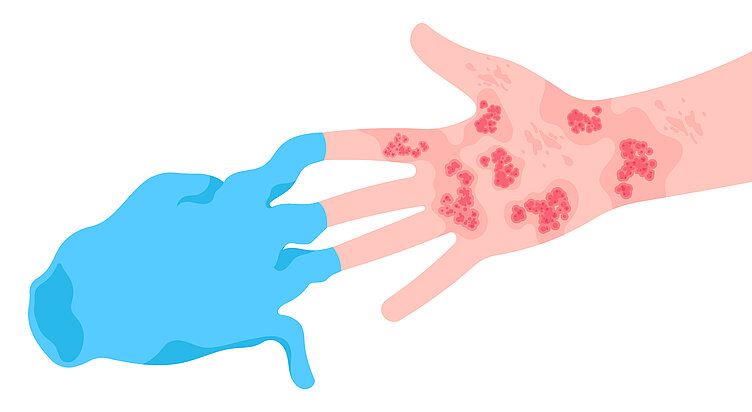
TYPE IV ALLERGIES:
REDUCING THE RISK OF SENSITIZATION WITH DPG- FREE GLOVES
Skin diseases are one of the most common occupational illnesses in Europe.¹
The primary among these is contact dermatitis², which can be divided into irritant toxic and allergic contact dermatitis ( Type I V allergy).

Allergic contact dermatitis
Allergic contact dermatitis (ACD) is triggered by a cellular immune reaction. Approximately 20% of the population have a predisposition to this condition.³ ⁴ ⁵
ACD often results in skin redness (erythema), itching, or burning eczema. In sensitized patients, the onset of symptoms typically takes 24 to 48 hours.
Contact dermatitis accounts for 95% of work-related skin diseases.² It is prevalent in the healthcare sector³, with nurses and nursing assistants accounting for the largest share at 40%, followed by medical assistants (22%) and physicians (18%).⁶

Our synthetic and DPG-free portfolio
Synthetic polyisoprene (IR) is chemically identical to natural rubber and therefore has the same physical properties as natural rubber. It is therefore ideal for the production of skin-friendly gloves, provided that
appropriate accelerators are used.
HARPS Global exclusively offers DPG-free products in its portfolio and does not use Thiurams in glove production.
OUR DPG- AND LATEX-FREE PORTFOLIO
For our conventionally crosslinked products (syntegra IR and syntegra green), we use an accelerator system consisting of a long-chain accelerator (from the dithiocarbamate group) in combination with a thermo-reactive molecule that decomposes residue-free during manufacturing.
For highly sensitized users, we offer a product (syntegra UV) that completely avoids the use of vulcanization accelerators. Instead, crosslinking is achieved through UV light. This product is therefore ideal for people with Type IV allergies.
References
¹ Bauer, A., Pesonen, M., Brans, R., Caroppo, F., Dickel, H., Dugonik, A., Filon, F. L., Geier, J., Arnau, A. G., Napolitano, M., Patruno, C., Rustemeyer, T., Simon, D., Schuttelaar, M. L. A., Śpiewak, R., Stingeni, L., Vok, M., Weißhaar, E., Wilkinson, S. M., . . . Uter, W. (2023). Occupational contact allergy: The European perspective–Analysis of patch test data from ESSCA between 2011 and 2020. Contact Dermatitis, 88(4), 263–274. https://doi.org/10.1111/ cod.14280https://doi.org/10.1111/cod.14280
² Bains, S. N., Nash, P. & Fonacier, L. (2018). Irritant contact dermatitis. Clinical Reviews in Allergy & Immunology, 56(1), 99–109. doi.org/10.1007/s12016-018-8713-0
³ Pesonen, M., Jolanki, R., Filon, F. L., Wilkinson, S. M., Kręcisz, B., Kieć-Swierczyńska, M., Bauer, A., Mahler, V., John, S. M., Schnuch, A. & Uter, W. (2015). Patch test results of the European baseline series among patients with occupational contact dermatitis across Europe – analyses of the European Surveillance System on Contact Allergy network, 2002–2010. Contact Dermatitis, 72(3), 154–163. doi.org/10.1111/cod.12333
⁴ Alinaghi, F., Bennike, N. H., Egeberg, A., Thyssen, J. P. & Johansen, J. D. (2018). Prevalence of contact allergy in the general population: A systematic review and meta‐analysis. Contact Dermatitis, 80(2), 77–85. doi/10.1111/cod.13119
⁵ Krob, H., Fleischer, A. B., D’Agostino, R. B., Haverstock, C. L. & Feldman, S. R. (2004). Prevalence and relevance of contact dermatitis allergens: A meta-analysis of 15 years of published T.R.U.E. test data. Journal Of The American Academy Of Dermatology, 51(3), 349–353. doi.org/10.1016/j.jaad.2003.11.069
⁶ Huang, C. H., Greig, D. & Cheng, H. (2021). Allergic contact dermatitis in healthcare workers. Occupational Medicine, 71(6–7), 294–297. https://doi.org/10.1093/occmed/kqab118 Allergic contact dermatitis in healthcare workers. Occupational Medicine, 71(6–7), 294–297. doi.org/10.1093/occmed/kqab118
⁷ Dejonckheere, G., Herman, A. & Baeck, M. (2019). Allergic contact dermatitis caused by synthetic rubber gloves in healthcare workers: Sensitization to 1,3‐diphenylguanidine is common. Contact Dermatitis, 81(3), 167–173. doi.org/10.1111/cod.13269
⁸ Baeck, M., Cawet, B., Tennstedt, D. & Goossens, A. (2012). Allergic contact dermatitis caused by latex (natural rubber)‐free gloves in healthcare workers. Contact Dermatitis, 68(1), 54–55. doi.org/10.1111/j.1600-0536.2012.02054.x
⁹ Cao, L., Taylor, J. S., Sood, A., Murray, D. A. & Siegel, P. D. (2010). Allergic Contact Dermatitis to Synthetic Rubber Gloves. Archives Of Dermatology, 146(9). doi.org/10.1001/archdermatol.2010.219
¹⁰ Geier, J., Lessmann, H., Mahler, V., Pohrt, U., Uter, W. & Schnuch, A. (2012). Occupational contact allergy caused by rubber gloves – nothing has changed. Contact Dermatitis, 67(3), 149–156. doi.org/10.1111/j.1600-0536.2012.02139.x
¹¹ Geier, J., Lessmann, H., Uter, W. & Schnuch, A. (2003). Occupational rubber glove allergy: results of the Information Network of Departments of Dermatology (IVDK), 1995-2001. Contact Dermatitis, 48(1), 39–44. doi.org/10.1034/j.1600-0536.2003.480107.x
¹² Pontén, A., Hamnerius, N., Bruze, M., Hansson, C., Persson, C., Svedman, C., Andersson, K. T. & Bergendorff, O. (2012). Occupational allergic contact dermatitis caused by sterile non‐latex protective gloves: clinical investigation and chemical analyses. Contact Dermatitis, 68(2), 103–110. doi.org/10.1111/cod.12010
¹³ Crépy, M. (2016). Rubber: new allergens and preventive measures. European Journal Of Dermatology, 26(6), 523–530. doi.org/10.1684/ejd.2016.2839
¹⁴ Services, D. O. H. A. H., Prevention, C. F. D. C. A. & Health, N. I. S. A. (2013). Effects of Skin Contact with Chemicals: What a Worker Should Know. CreateSpace.


